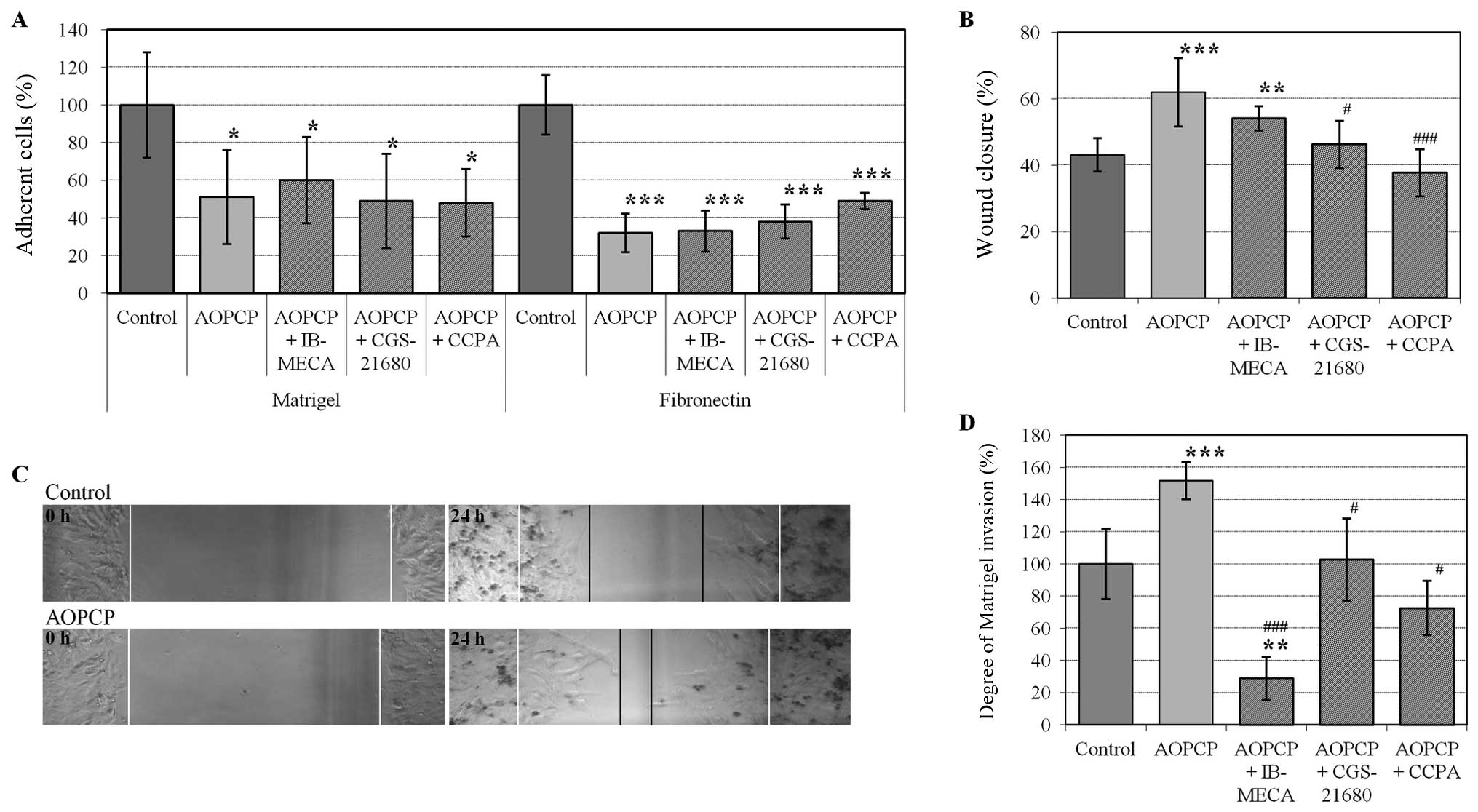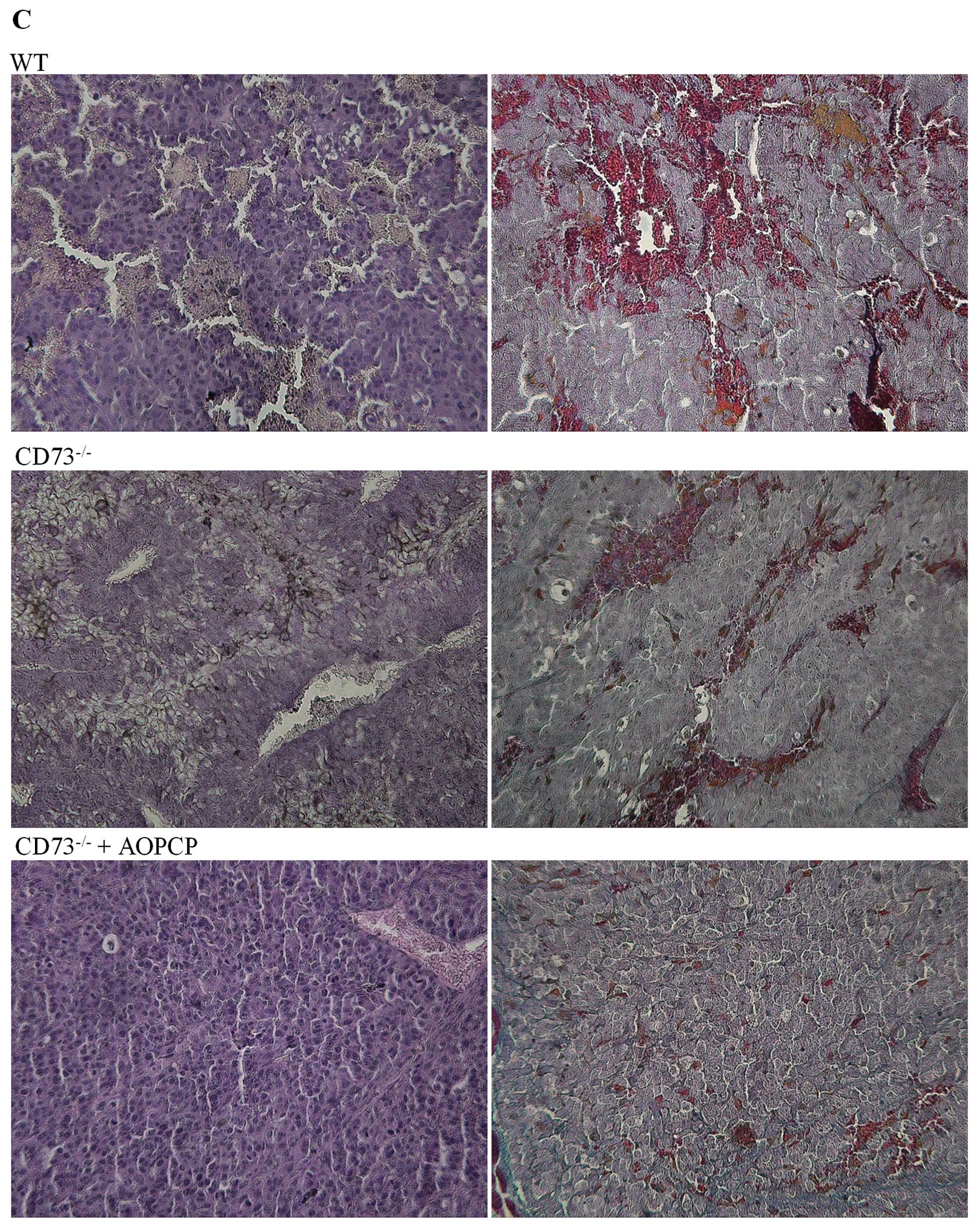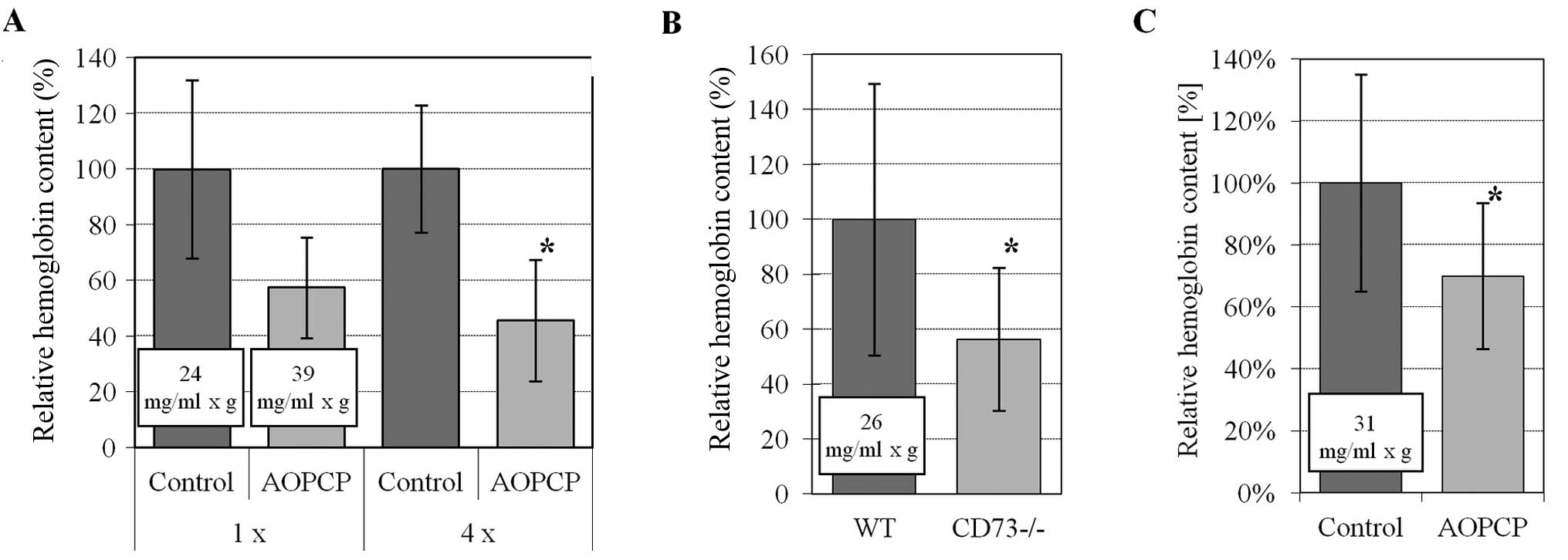|
1
|
Zimmermann B: 5′-Nucleotidase: molecular
structure and functional aspects. Biochem J. 285:345–365. 1992.
|
|
2
|
Bianchi V and Spychala J: Mammalian
5′-nucleotidases. J Biol Chem. 278:46195–46198. 2003.
|
|
3
|
Bly J, White TD and Hoskin DW: The
extracellular fluid of solid carcinomas contains immunosuppressive
concentrations of adenosine. Cancer Res. 57:2602–2605.
1997.PubMed/NCBI
|
|
4
|
Merighi S, Baraldi PG, Gessi S, Iannotta
V, Klotz KN, Leung E, Mirandola P, Tabrizi MA, Varani K and Borea
PA: Adenosine receptors and human melanoma. Drug Dev Res.
58:377–385. 2003. View Article : Google Scholar
|
|
5
|
Bergers G and Benjamin LE: Tumorigenesis
and the angiogenic switch. Nat Rev Cancer. 3:401–410. 2003.
View Article : Google Scholar
|
|
6
|
Auchampach JA: Adenosine receptors and
angiogenesis. Circ Res. 101:1075–1077. 2007. View Article : Google Scholar : PubMed/NCBI
|
|
7
|
Fishman P, Bar-Yehuda S, Synowitz M,
Powell JD, Klotz KN, Gessi S and Borea PA: Adenosine receptors and
cancer. Adenosine Receptors in Health and Disease, Handbook of
Experimental Pharmacology. Wilson CN and Mustafa SJ:
Springer-Verlag; Berlin: pp. 399–441. 2009, View Article : Google Scholar
|
|
8
|
Stagg J and Smyth MJ: Extracellular
adenosine triphosphate and adenosine in cancer. Oncogene.
29:5346–5358. 2010. View Article : Google Scholar : PubMed/NCBI
|
|
9
|
Stagg J, Divisekera U, Duret H, Sparwasser
T, Teng MW, Darcy PK and Smyth MJ: CD73-deficient mice have
increased anti-tumor immunity and are resistant to experimental
metastasis. Cancer Res. 71:2892–2900. 2011. View Article : Google Scholar : PubMed/NCBI
|
|
10
|
Resta R, Yamashita Y and Thompson LF:
Ecto-enzyme and signaling functions of lymphocyte CD73. Immunol
Rev. 161:95–109. 1998. View Article : Google Scholar : PubMed/NCBI
|
|
11
|
Stochaj U, Dieckhoff J, Mollenhauer J,
Cramer M and Mannherz HG: Evidence for the direct interaction of
chicken gizzard 5′-nucleotidase with laminin and fibronectin.
Biochim Biophys Acta. 992:385–392. 1989.
|
|
12
|
Sadej R, Spychala J and Skladanowski AC:
Expression of ecto-5′-nucleotidase (eN, CD73) in cell lines from
various stages of human melanoma. Melanoma Res. 16:213–222.
2006.
|
|
13
|
Orend G and Chiquet-Ehrismann R: Adhesion
modulation by antiadhesive molecules of the extracellular matrix.
Exp Cell Res. 261:104–110. 2000. View Article : Google Scholar : PubMed/NCBI
|
|
14
|
Sadej R, Inai K, Rajfur Z, Ostapkowicz A,
Kohler J, Skladanowski AC, Mitchell BS and Spychala J: Tenascin C
interacts with Ecto-5′-nucleotidase (eN) and regulates adenosine
generation in cancer cells. Biochim Biophys Acta. 1782:35–40.
2008.PubMed/NCBI
|
|
15
|
Yegutkin GG, Marttila-Ichihara F,
Karikoski M, Niemelä J, Laurila JP, Elima K, Jalkanen S and Salmi
M: Altered purinergic signaling in CD73-deficient mice inhibits
tumor progression. Eur J Immunol. 41:1231–1241. 2011. View Article : Google Scholar : PubMed/NCBI
|
|
16
|
Forte G, Sorrentino R, Montinaro A,
Luciano A, Adcock IM, Maiolino P, Arra C, Cicala C, Pinto A and
Morello S: Inhibition of CD73 improves B cell-mediated anti-tumor
immunity in a mouse model of melanoma. J Immunol. 189:2226–2233.
2012. View Article : Google Scholar : PubMed/NCBI
|
|
17
|
Zhou X, Zhi X, Zhou P, Chen S, Zhao F,
Shao Z, Ou Z and Yin L: Effects of ecto-5′-nucleotidase on human
breast cancer cell growth in vitro and in vivo. Oncol
Rep. 17:1341–1346. 2007.
|
|
18
|
Wang L, Tang S, Wang Y, Xu S, Yu J, Zhi X,
Ou Z, Yang J, Zhou P and Shao Z: Ecto-5′-nucleotidase (CD73)
promotes tumor angiogenesis. Clin Exp Metastasis. 30:671–680.
2013.
|
|
19
|
Eroglu A, Canbolat O, Demirci S, Kocaoglu
H, Eryavuz Y and Akgül H: Activities of adenosine deaminase and
5′-nucleotidase in cancerous and noncancerous human colorectal
tissues. Med Oncol. 17:319–324. 2000.
|
|
20
|
Wang L, Zhou X, Zhou T, Ma D, Chen S, Zhi
X, Yin L, Shao Z, Ou Z and Zhou P: Ecto-5′-nucleotidase promotes
invasion, migration and adhesion of human breast cancer cells. J
Cancer Res Clin Oncol. 134:365–372. 2008.
|
|
21
|
Pohl AL, Reiner G, Kolb R, Sauermann G,
Moser KV and Spona J: Enzyme activities in human breast tumor cells
and sera. Cancer Detect Prev. 8:57–66. 1985.PubMed/NCBI
|
|
22
|
Krüger KH, Thompson LF, Kaufmann M and
Möller P: Expression of ecto-5′-nucleotidase (CD73) in normal
mammary gland and in breast carcinoma. Br J Cancer. 63:114–118.
1991.
|
|
23
|
Supernat A, Markiewicz A,
Welnicka-Jaskiewicz M, Seroczynska B, Skokowski J, Sejda A, Szade
J, Czapiewski P, Biernat W and Zaczek A: CD73 expression as a
potential marker of good prognosis in breast carcinoma. Appl
Immunohistochem Mol Morphol. 20:103–107. 2012. View Article : Google Scholar : PubMed/NCBI
|
|
24
|
Raz A, McLella WL, Hart IR, Bucana CD,
Hoyer LC, Sela BA, Dragsten P and Fidler IJ: Cell surface
properties of B16 melanoma variants with differing metastatic
potential. Cancer Res. 40:1645–1651. 1980.PubMed/NCBI
|
|
25
|
Schroeder F and Gardiner JM: Membrane
lipids and enzymes of cultured high-and low-metastatic B16 melanoma
variants. Cancer Res. 44:3262–3269. 1984.PubMed/NCBI
|
|
26
|
Koszalka P, Özüyaman B, Huo Y, Zernecke A,
Flögel U, Braun N, Buchheiser A, Decking UKM, Smith ML, Sévigny J,
Gear A, Weber A, Molojavyi A, Ding Z, Weber C, Ley K, Zimmermann H,
Gödecke A and Schrader J: Targeted disruption of
cd73/ecto-5′-nucleotidase alters thromboregulation and augments
vascular inflammatory response. Circ Res. 95:814–821. 2004.
|
|
27
|
Shaw LM: Tumor cell invasion assays:
methods in molecular biology. Cell Migration: Developmental Methods
and Protocols. Guan JL: 294. Humana Press Inc; New York: pp.
97–105. 2005, View Article : Google Scholar : PubMed/NCBI
|
|
28
|
Morabito L, Montesinos MC, Schreibman DM,
Balter L, Thompson LF, Resta R, Carlin G, Huie MA and Cronstein BN:
Methotrexate and sulfasalazine promote adenosine release by a
mechanism that requires ecto-5′-nucleotidase-mediated conversion of
adenine nucleotides. J Clin Invest. 101:295–300. 1998.PubMed/NCBI
|
|
29
|
St Hilaire C, Ziegler SG, Markello TC, et
al: NT5E mutations and arterial calcifications. N Engl J Med.
364:432–442. 2011.PubMed/NCBI
|
|
30
|
Flocke K and Mannherz HG: Isolation and
characterization of 5′-nucleotidase of a human pancreatic tumor
cell line. Biochim Biophys Acta. 1076:273–281. 1991.
|
|
31
|
Ria R, Reale A, Castrovilli A, Mangialardi
G, Dammacco F, Ribatti D and Vacca A: Angiogenesis and progression
in human melanoma. Dermatol Res Pract. Article ID 185687.
View Article : Google Scholar : 2010.
|
|
32
|
Widnell CC, Schneider YJ, Pierre B,
Baudhuin P and Trout A: Evidence for a continual exchange of
5′-nucleotidase between the cell surface and cytoplasmic membranes
in cultured rat fibroblasts. Cell. 28:61–70. 1982.
|
|
33
|
van den Bosch R, Geuze HJ, du Maine APM
and Strous GJ: Transport and metabolism of 5′-nucleotidase in a rat
hepatoma cell line. Eur J Biochem. 160:49–54. 1986.
|
|
34
|
Airas L, Niemelä J, Salmi M, Puurunen T,
Smith DJ and Jalkanen S: Differential regulation and function of
CD73, a glycosyl-phosphatidylinositol-linked 70-kD adhesion
molecule, on lymphocytes and endothelial cells. J Cell Biol.
136:421–431. 1997. View Article : Google Scholar : PubMed/NCBI
|
|
35
|
Chatterjee SK, Kim U and Bielat K: Plasma
membrane associated enzymes of mammary tumors as the biochemical
indicators of metastasizing capacity. Analyses of enriched plasma
membrane preparations. Br J Cancer. 33:15–26. 1976. View Article : Google Scholar
|
|
36
|
Lugassy C, Vernon SE, Busam K, Engbring
JA, Welch DR, Poulos EG, Kleinman HK and Barnhill RL: Angiotropism
of human melanoma: studies involving in transit and other cutaneous
metastases and the chicken chorioallantoic membrane: implications
for extravascular melanoma invasion and metastasis. Am J
Dermatopathol. 28:187–193. 2006. View Article : Google Scholar
|
|
37
|
Stochaj U, Richter H and Mannherz HG:
Chicken gizzard 5′-nucleotidase is a receptor for the extracellular
matrix component fibronectin. Eur J Cell Biol. 51:335–338.
1990.
|
|
38
|
Sträter N: Ecto-5′-nucleotidase: Structure
function relationships. Purinergic Signal. 2:343–350. 2006.
|
|
39
|
Méhul B, Aubery M, Mannherz HG and Codogno
P: Dual mechanism of laminin modulation of ecto-5′-nucleotidase
activity. J Cell Biochem. 52:266–274. 1993.PubMed/NCBI
|
|
40
|
Murphy BJ: Regulation of malignant
progression by the hypoxia-sensitive transcription factors HIF-1a
and MTF-1. Comp Biochem Physiol B Biochem Mol Biol. 139:495–507.
2004. View Article : Google Scholar : PubMed/NCBI
|
|
41
|
Ohta A and Sitkovsky M: Role of
G-protein-coupled adenosine receptors in downregulation of
inflammation and protection from tissue damage. Nature.
414:916–920. 2001. View Article : Google Scholar : PubMed/NCBI
|
|
42
|
Spychala J: Tumor-promoting functions of
adenosine. Pharmacol Ther. 87:161–173. 2000. View Article : Google Scholar
|
|
43
|
Merighi S, Simioni C, Gessi S, Varani K,
Mirandola P, Tabrizi MA, Baraldi PG and Borea PA: A2B
and A3 adenosine receptors modulate vascular endothelial
growth factor and interleukin-8 expression in human melanoma cells
treated with etoposide and doxorubicin. Neoplasia. 11:1064–1073.
2009.
|
|
44
|
Tufto I, Lyng H and Rofstad EK: Vascular
density in human melanoma xenografts: relationship to angiogenesis,
perfusion and necrosis. Cancer Lett. 123:159–165. 1998. View Article : Google Scholar : PubMed/NCBI
|
|
45
|
Norrby K: In vivo models of angiogenesis.
J Cell Mol Med. 10:588–612. 2006. View Article : Google Scholar : PubMed/NCBI
|
|
46
|
Pötgens AJ, Lubsen NH, van Altena MC,
Schoenmakers JG, Ruiter DJ and de Waal RM: Vascular permeability
factor expression influences tumor angiogenesis in human melanoma
lines xenografted to nude mice. Am J Pathol. 146197–146209.
1995.PubMed/NCBI
|















